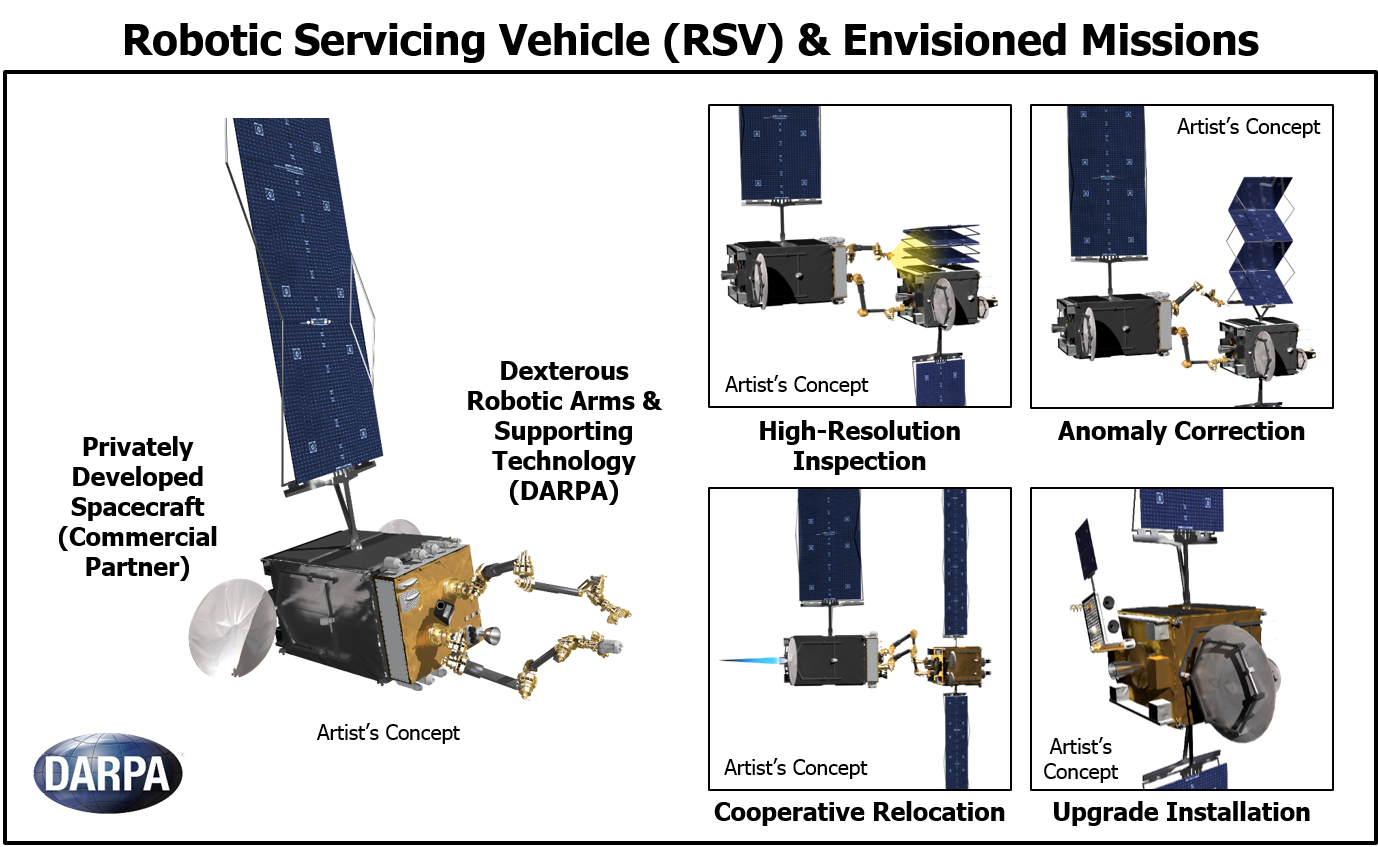The Defense Advanced Research Projects Agency is on track to announce a new commercial partner for its robotic servicing payload by the end of the year, with plans to have a spacecraft in orbit in 2022.
“I’m standing here with a smile on my face. The program is moving forward and things are looking good and we’re very hopeful,” Joe Parrish, program manager for the Robotic Servicing of Geosynchronous Spacecraft program at DARPA, said at the 2019 Global Satellite Servicing Forum Oct. 1. “We’re looking to launch RSGS in late 2022.”
RSGS is intended to deliver a GEO spacecraft with a payload consisting of two large 2 meter arms and a number of tools that will allow it to perform maintenance and other work on satellites in GEO. The spacecraft will perform four main functions in space: inspection, orbital adjustments, anomaly resolution and installation of self-contained payloads.
With a host of cameras onboard, RSGS will be able to inspect other satellites. This can help operators on the ground diagnose problems and inform in-orbit repairs. It can also use its arms to capture a satellite and move it, either to a new orbit or to dispose of it. DARPA envisions RSGS being able, again using its arms, to install new payloads on existing satellites, replacing legacy hardware and augmenting its mission for years to come. And, of course, RSGS will be available to traverse the GEO landscape to help satellites that fail to deploy correctly.
“If somebody launches up into GEO while we’re up there and a solar array fails to deploy or a reflector or antenna fails to deploy, we can come galloping to the rescue,” said Perrish. “The benefit is not to demonstrate robot arms waving around in space. The benefit is to increase the resilience of our infrastructure in space.”
While DARPA is developing the payload with robotic arms, according to Parrish, DARPA needs a commercial partner to build the spacecraft that will house the payload and carry it around in orbit.

“We’re looking for the partner to provide the spacecraft bus — so using a heritage GEO bus that may have had some tailoring for RSGS requirements, integrating the payload and the spacecraft bus together, procuring and launching that integrated spacecraft to GEO, and then providing mission control center for operations for a long period of time,” explained Parrish.
Parrish said that the full project would be turned over in due time to the commercial partner to operate RSGS for fun and profit.
But DARPA has hit some stumbling blocks in securing that commercial partner.
In 2017, Orbital ATK sued DARPA to stop it from developing what it saw as competition to its own satellite servicing space vehicle. While that effort failed, the company’s efforts to develop its own satellite servicing program have continued. Orbital ATK was acquired by Northrop Grumman in 2018, and now the Northrop Grumman subsidiary SpaceLogistics is preparing to launch the first satellite life extension vehicle into space in the coming weeks.
Then, in January, Maxar Technologies’ Space Systems Loral pulled out of an agreement with DARPA to build the spacecraft to host the RSGS payload because the program didn’t deliver the financial returns it was hoping for.
DARPA has spent much of the last year working to find a new commercial partner. In May they hosted a Proposer’s Day to discuss the program with potentially interested companies, and now Parrish says they expect to announce a partner toward the end of the year.
“2019 has been quite a year,” said Parrish. “We are still in source selection for a new commercial partner.”
Meanwhile, work on the payload itself is ongoing.
The first of two flight robotic manipulator arms is in final assembly and will be shipped to the Naval Research Lab in the next two weeks, where it will be integrated into the payload. The second arm lags the first by about two months, said Parrish, and is currently in assembly.
In 2020, all of the components of the payload will be sent to NRL for assembly into the actual payload.
Nathan Strout covers space, unmanned and intelligence systems for C4ISRNET.








